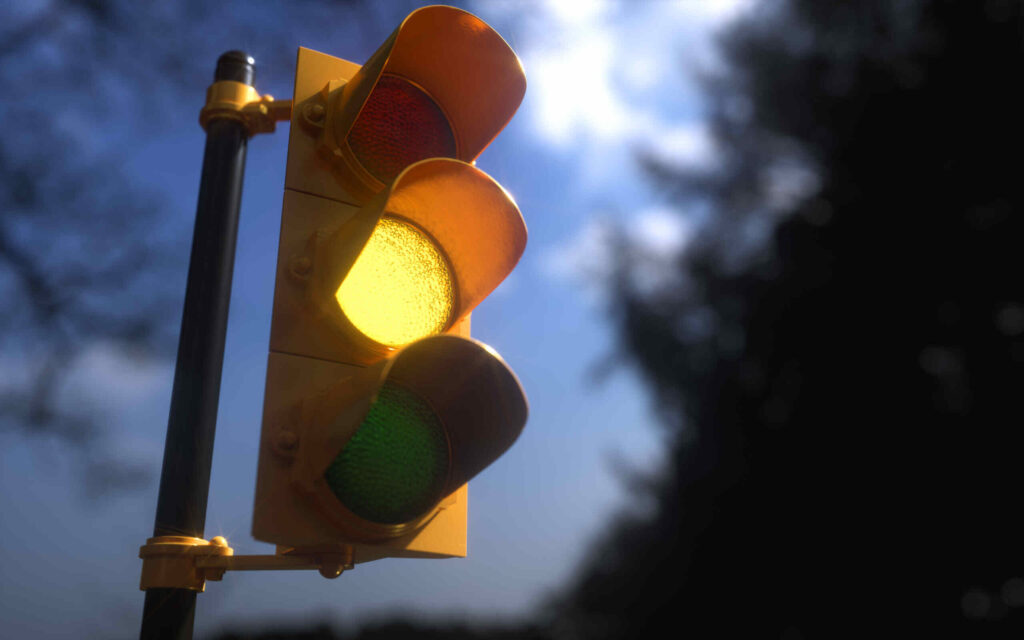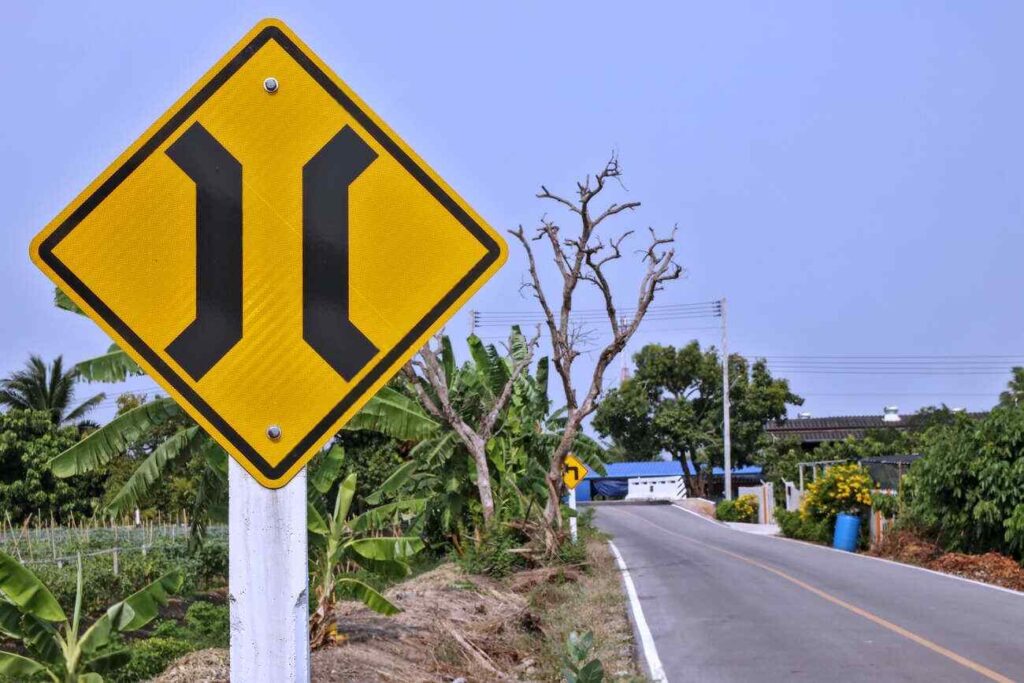Traffic lights help control cars on the road. They prevent crashes and keep things moving. A blinking yellow light is one type of signal. It tells drivers to be careful. Understanding it can make you a better driver. Let’s look at the basics first.
The Basics of Traffic Lights
Traffic lights use colors to guide drivers. Red means stop. Green means go. Yellow has different meanings based on if it is steady or flashing.
A steady red light requires a full stop. You wait until it turns green. A green light lets you go if the path is clear. But yellow lights need more attention.
There are two main types of yellow lights. One is solid yellow. The other is blinking yellow. They do not mean the same thing. Mixing them up can lead to mistakes.
What Does a Blinking Yellow Light Mean?
A blinking yellow light means proceed with caution. You do not have to stop. But you must slow down and check for dangers. Look for other cars, people walking, or bikes.
This light often shows up at night or when traffic is light. It keeps things flowing without full stops. For example, at a four-way intersection, one side might have a blinking yellow. The other side could have a blinking red.
When you see it, reduce your speed. Scan the area. Make sure no one is crossing. If it is safe, you can go through. This rule applies in most places in the US.
Think of it like a yield sign. You have the right of way. But you yield if needed. This helps avoid stops when not necessary.
In some cases, it is a flashing yellow arrow. This is for turns. It means you can turn left after yielding to oncoming cars. Always check for people in the crosswalk.
Blinking yellow lights save time. They reduce waits at quiet times. But safety comes first. Always be ready to stop if something looks wrong.
Flashing Yellow Traffic Light Rules
Now, let’s talk about the rules for flashing yellow traffic lights. These rules are clear in most states. Follow them to stay safe.
First, slow down as you approach. Do not speed up. Look left and right. Check for cars coming from other directions.
If you are going straight, proceed if clear. For turns, yield to traffic with the right of way. This includes cars going straight from the opposite side.
Pedestrians have priority. If someone is crossing, stop and wait. Do not try to go around them.
In bad weather, be extra careful. Rain or fog can hide dangers. Use your headlights if needed.
What if the light is flashing yellow on all sides? This is rare. Treat it like a busy area. Take turns if no one has clear priority.
These rules come from traffic laws. They aim to prevent accidents. In the US, the Federal Highway Administration sets guidelines. States follow them closely.
For example, in California, a blinking yellow means be careful and slow down. You can go if safe. The same goes for New York.
If you ignore these rules, you could get a ticket. Worse, you might cause a crash. Always follow them.
Here are some key flashing yellow traffic light rules in a list:
- Reduce speed right away.
- Look for other vehicles.
- Yield to pedestrians.
- Proceed only if the path is clear.
- Do not assume others will stop.
These steps make driving safer for everyone.
Blinking Yellow Light vs Solid Yellow Light
Many drivers mix up blinking yellow and solid yellow lights. They are different. Knowing the difference can prevent problems.
A solid yellow light means the signal is about to turn red. You should stop if you can do it safely. If you are too close, go through carefully. It is a warning to prepare for a stop.
On the other hand, a blinking yellow light does not mean stop. It means go ahead but be cautious. You keep moving if safe. No need to stop unless there is danger.
For turns, a solid yellow arrow means the turn time is ending. Stop if possible. A flashing yellow arrow means turn after yielding.
Why the difference? Solid yellow is part of the normal cycle. It follows green and leads to red. Blinking yellow is for special times, like when the light is not in full mode.
In a table, here’s a quick comparison:
| Aspect | Blinking Yellow Light | Solid Yellow Light |
|---|---|---|
| Meaning | Proceed with caution, no stop needed | Prepare to stop, light turning red |
| Action | Slow down, check, go if safe | Stop if you can safely |
| Common Use | Low traffic times, intersections | Normal signal cycle |
| For Turns | Yield to oncoming traffic | End of protected turn |
| Risk if Ignored | Could miss dangers | Running red light |
This table shows the main points. Remember, solid yellow is a transition. Blinking yellow is a caution signal.
Confusing them can lead to tickets or crashes. For instance, stopping at a blinking yellow can cause rear-end hits. Speeding through a solid yellow might mean running a red.
Learn these differences. It will help you drive better.
When and Where You See Blinking Yellow Lights
Blinking yellow lights appear in certain spots. Knowing where helps you prepare.
They often show at intersections with low traffic. Like late at night or early morning. The light switches to flash mode to save energy and time.
You might see them near schools or pedestrian areas. They warn drivers to watch for kids crossing.
In construction zones, flashing yellow means slow down. There could be workers or changes in the road.
Some places use them for left turns. The flashing yellow arrow lets you turn when safe. This is common in busy cities.
Rural areas use them too. Where traffic is sparse, full signals are not needed all day.
Weather can trigger them. If power goes out, lights might flash yellow or red.
In short, expect them where caution is key but stops are not always required.
Safety Tips for Blinking Yellow Lights
Safety is important at any light. Here are tips for blinking yellow lights.
First, always slow down. Even if you have the right of way, reduce speed.
Look in all directions. Check mirrors and blind spots.
Watch for pedestrians. They might not see the light well at night.
If turning, wait for a clear gap. Do not force it.
Keep distance from the car ahead. This gives room to react.
Use signals. Let others know your plans.
In groups, do not follow blindly. Each driver must check.
Teach new drivers these tips. Practice in low-traffic areas.
If unsure, treat it like a yield. Better safe than sorry.
These tips can cut down on accidents. Many crashes happen because drivers rush.
Common Mistakes and How to Avoid Them
Drivers make errors at flashing yellow lights. Here are common ones and fixes.
One mistake is stopping when not needed. This can cause backups or rear-ends. Fix: Remember, blinking means go with caution.
Another is speeding through. Some treat it like green. Fix: Always slow and look.
Not yielding for turns is bad. It leads to side crashes. Fix: Wait for clear path.
Confusing it with solid yellow. Some stop hard. Fix: Know the differences.
Ignoring pedestrians. They have rights. Fix: Always check crosswalks.
Driving distracted. Phone use is risky. Fix: Focus on the road.
To avoid these, stay alert. Follow rules. Practice makes it easier.
Variations in Different States
Rules are mostly the same across the US. But some states have small changes.
In Minnesota, flashing yellow arrows are common for left turns. You yield then go.
California treats blinking yellow as caution. Same in Florida.
Pennsylvania says slow, look, proceed.
Some states use them more in cities. Others in rural spots.
Check your state’s DMV for specifics. But basics stay the same.
Outside the US, rules differ. In Canada, similar to US. In Europe, flashing yellow might mean no control.
For US drivers, focus on caution.
History of Traffic Signals and Blinking Yellow Lights
Traffic lights have a long past. They started in the 1800s.
First ones were for trains. Red for stop, green for go.
In 1868, London had the first street light. It used gas.
In the US, electric lights came in 1912. But no yellow yet.
Garrett Morgan added yellow in 1923. His patent had a caution step.
Flashing modes came later. For off-hours.
In the 1930s, flashing yellow meant caution at busy spots.
By the 2000s, flashing yellow arrows improved turns. They reduce waits and crashes.
Today, lights are smart. They change based on traffic.
This history shows how signals evolved for safety.
What to Do if You See a Malfunctioning Light
Sometimes lights break. They might flash wrong or not at all.
If all sides flash yellow, proceed with care. Take turns.
If no light, treat as four-way stop.
Report it to authorities. Use 311 or local number.
Do not assume it’s fixed. Wait for help if needed.
In storms, power outs cause this. Be ready.
Impact on Road Safety
Blinking yellow lights help safety. They reduce stops, which cuts rear-ends.
But they need proper use. Studies show fewer crashes with flashing arrows.
Still, caution is key. Many accidents happen from not yielding.
Education helps. Driver courses teach this.
Tips for New Drivers
If you are new, practice at quiet intersections.
Ask a teacher about blinking lights.
Watch videos on rules.
Start slow. Build confidence.
For more information visit Traffic signs test.
Conclusion
A blinking yellow light means proceed with caution. Slow down, check, go if safe. It differs from solid yellow, which means stop soon.
Follow flashing yellow traffic light rules. Know blinking yellow light vs solid yellow light.
This knowledge makes roads safer. Drive smart.


